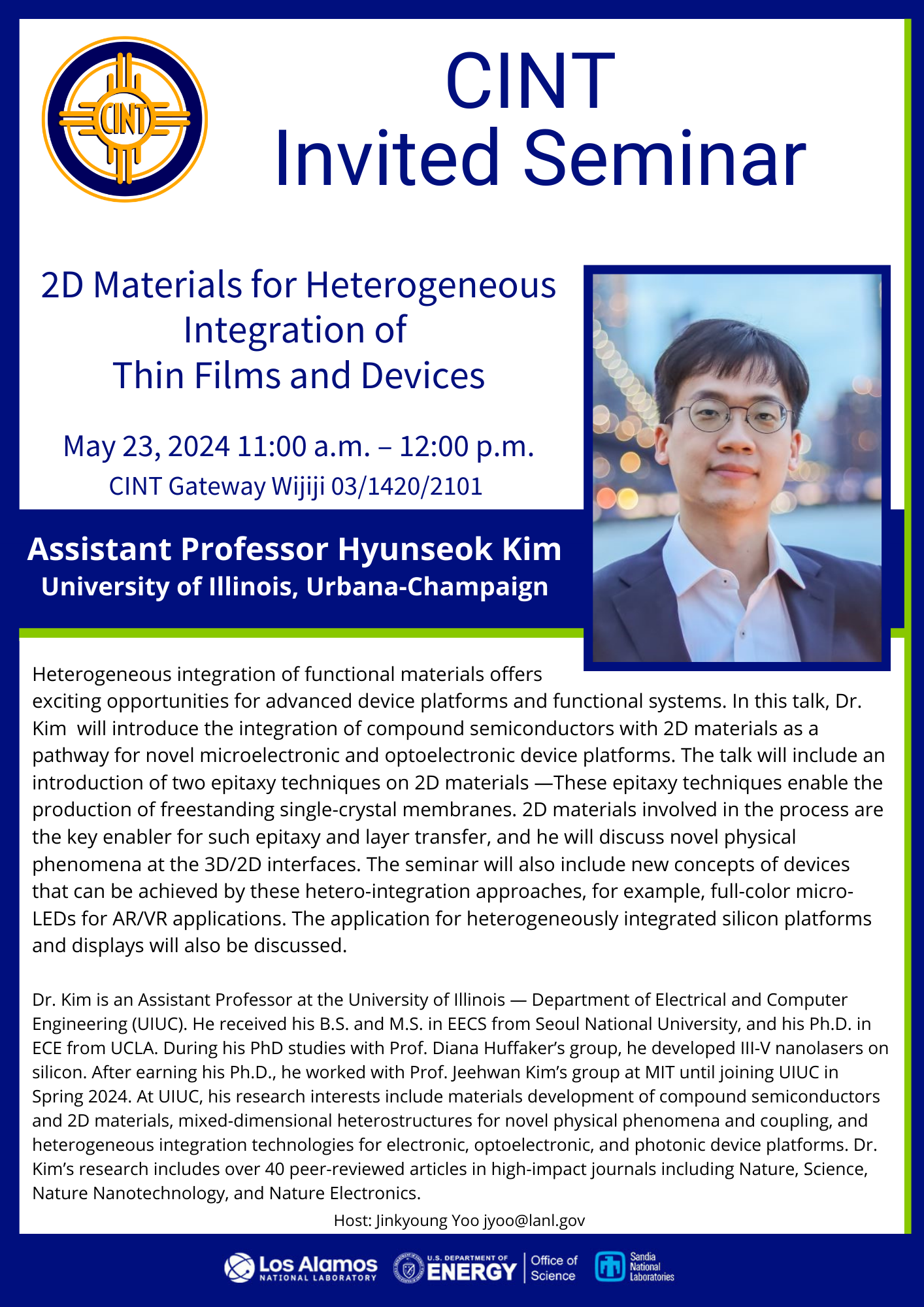
Join Assistant Professor Hyunseok Kim for his talk — 2D Materials for Heterogeneous Integration of Thin Films and Devices.
CINT — Gateway
Wijiji Conference Room
03/1420/2101
Los Alamos National Laboratory
Heterogeneous integration of functional materials offers exciting opportunities for advanced device platforms and functional systems. In this talk, Dr. Kim will introduce the integration of compound semiconductors with 2D materials as a pathway for novel microelectronic and optoelectronic device platforms. The talk will include an introduction of two epitaxy techniques on 2D materials —These epitaxy techniques enable the production of freestanding single-crystal membranes. 2D materials involved in the process are the key enabler for such epitaxy and layer transfer, and he will discuss novel physical phenomena at the 3D/2D interfaces. The seminar will also include new concepts of devices that can be achieved by these hetero-integration approaches, for example, full-color micro-LEDs for AR/VR applications. The application for heterogeneously integrated silicon platforms and displays will also be discussed.
Dr. Kim is an Assistant Professor at the University of Illinois — Department of Electrical and Computer Engineering (UIUC). He received his B.S. and M.S. in EECS from Seoul National University, and his Ph.D. in ECE from UCLA. During his PhD studies with Prof. Diana Huffaker’s group, he developed III-V nanolasers on silicon. After earning his Ph.D., he worked with Prof. Jeehwan Kim’s group at MIT until joining UIUC in Spring 2024. At UIUC, his research interests include materials development of compound semiconductors and 2D materials, mixed-dimensional heterostructures for novel physical phenomena and coupling, and heterogeneous integration technologies for electronic, optoelectronic, and photonic device platforms. His research includes over 40 peer-reviewed articles in high-impact journals including Nature, Science, Nature Nanotechnology, and Nature Electronics.
Host: Jinkyoung Yoo jyoo@lanl.gov

The strangeness of quantum physics is being harnessed to revolutionize computing as we know it. Join us for a week-long summer campfor science, technology, engineering, and mathematics (STEM) teachers and students. You will get a primer on the fundamentals of computing, learn hands-on the often perplexing phenomena of quantum physics, and apply those phenomena to solve computing problems in new ways. Participants will interact with world-class scientists, engineers, and leaders and gain experience in this rapidly growing field to bring their classrooms and communities!
Camp dates: July 1 -26, 2024
Format: In-person (Albuquerque, NM and Berkeley, CA) and Virtual options.
Time: 9:30am – 4:30pm (MT), M-F
Student Stipend: $500/week
Questions? Email us at QCaMP@sandia.gov or visit https://quantumsystemsaccelerator.org/qcamp/
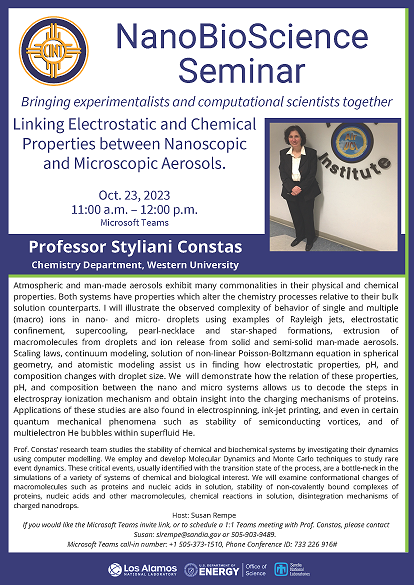
Bringing experimentalists and computational scientists together
Center for Integrated Nanotechologies, Sandia National Laboratories
Albuquerque, NM
Virtual: Microsoft Teams
Call in number: +1 505-373-1510
Meeting ID number: 733 226 916#
Join Professor Styliana Constas for her talk — Linking Electrostatic and Chemical Properties
between Nanoscopic and Microscopic Aerosols.
Atmospheric and man-made aerosols exhibit many commonalities in their physical and chemical properties. Both systems have properties which alter the chemistry processes relative to their bulk solution counterparts. Professor Constas will illustrate the observed complexity of behavior of single and multiple (macro) ions in nano- and micro- droplets using examples of Rayleigh jets, electrostatic confinement, supercooling, pearl-necklace and star-shaped formations, extrusion of macromolecules from droplets and ion release from solid and semi-solid man-made aerosols. Scaling laws, continuum modeling, solution of non-linear Poisson-Boltzmann equation in spherical geometry, and atomistic modeling will assist us in finding how electrostatic properties, pH, and composition changes with droplet size. She will demonstrate how the relation of these properties,pH, and composition between the nano and micro systems allows us to decode the steps in electrospray ionization mechanism and obtain insight into the charging mechanisms of proteins. Applications of these studies are also found in electrospinning, ink-jet printing, and even in certain quantum mechanical phenomena such as stability of semiconducting vortices, and of multi-electron He bubbles within superfluid He.
Prof. Constas’ research team studies the stability of chemical and biochemical systems by investigating their dynamics using computer modeling. They employ and develop Molecular Dynamics and Monte Carlo techniques to study rare event dynamics. These critical events, usually identified with the transition state of the process, are a bottle-neck in the simulations of a variety of systems of chemical and biological interest. They examine conformational changes of macromolecules such as proteins and nucleic acids in solution, stability of non-covalently bound complexes of proteins, nucleic acids and other macromolecules, chemical reactions in solution, disintegration mechanisms of charged nanodrops.
Host: Susan Rempe
If you would like the Microsoft Teams invite link, or to schedule a 1:1 Teams meeting with Prof. Constas, please contact Susan: slrempe@sandia.gov or 505-903-9489.
Microsoft Teams call-in number: +1 505-373-1510, Phone Conference ID: 733 226 916#
Join us and learn everything you've ever wanted to know about nanofabrication at CINT.
We plan to cover topics from introductory level to advanced level.
Center for Integrated Nanotechologies, Sandia National Laboratories
Albuquerque, NM, USA
Last Tuesday of each month (through 2023)
3:30–4:30
CINT CORE Rooms 1026 & 518 (attendees must be badged to attend)
Host — Keshab Raj Sapkota
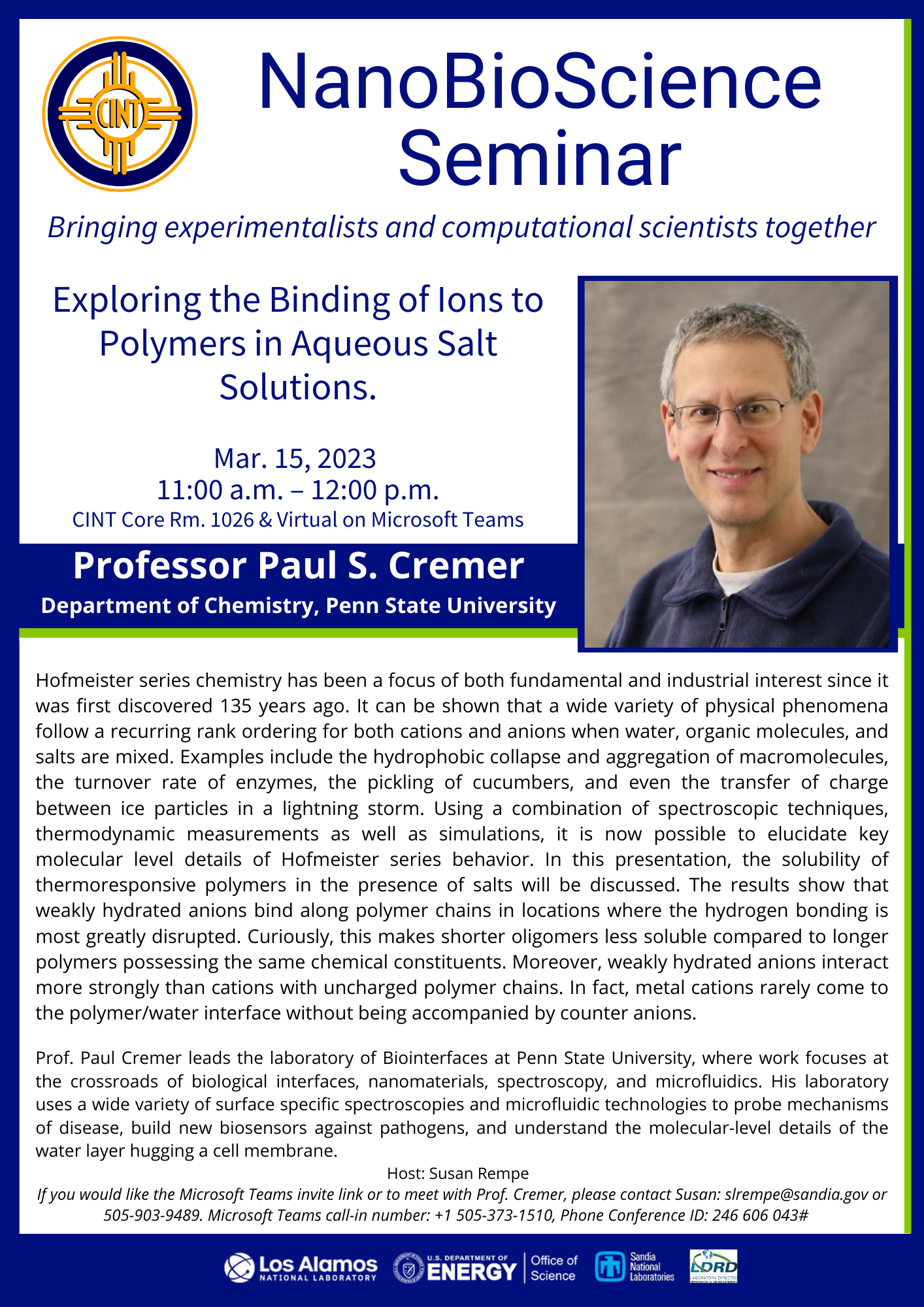
Bringing experimentalists and computaional scientists together
Center for Integrated Nanotechologies, Sandia National Laboratories
Albuquerque, NM
CINT Core Rooms 1026 (LANL/Sandia staff only) & Virtual
Virtual: Microsoft Teams
Call in number: +1 505-373-1510
Meeting ID number: 246 606 043#
Join Professor Paul S. Cremer for his talk — Exploring the Binding of Ions to Polymers in Aqueous Salt Solutions.
Abstract: Hofmeister series chemistry has been a focus of both fundamental and industrial interest since it was first discovered 135 years ago. It can be shown that a wide variety of physical phenomena follow a recurring rank ordering for both cations and anions when water, organic molecules, and salts are mixed. Examples include the hydrophobic collapse and aggregation of macromolecules, the turnover rate of enzymes, the pickling of cucumbers, and even the transfer of charge between ice particles in a lightning storm. Using a combination of spectroscopic techniques, thermodynamic measurements as well as simulations, it is now possible to elucidate key molecular level details of Hofmeister series behavior. In this presentation, the solubility of thermoresponsive polymers in the presence of salts will be discussed. The results show that weakly hydrated anions bind along polymer chains in locations where the hydrogen bonding is most greatly disrupted. Curiously, this makes shorter oligomers less soluble compared to longer polymers possessing the same chemical constituents. Moreover, weakly hydrated anions interact more strongly than cations with uncharged polymer chains. In fact, metal cations rarely come to the polymer/water interface without being accompanied by counter anions.
Host: Susan Rempe — slrempe@sandia.gov or 505-903-9489.
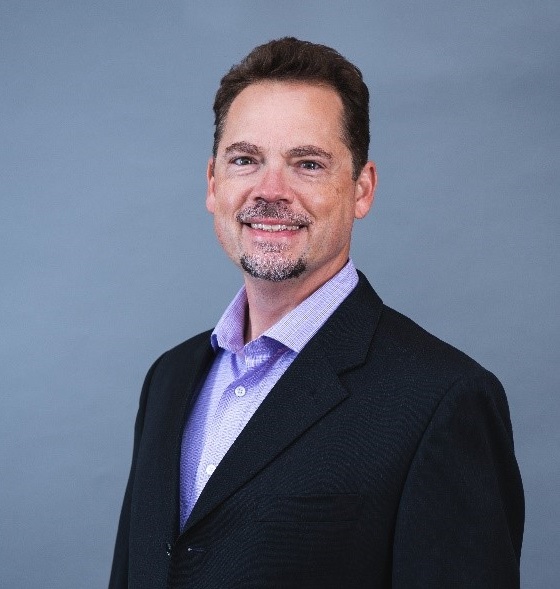
Join CINT Co-Director Adam Rondinone for his talk, “Overview of the Nanoscale Science Research Centers and Opportunities in Microelectronics” during a live webinar exploring the work carried out at the Department of Energy’s Nanoscale Science Research Centers.
https://physicsworld.com/a/focus-on-u-s-department-of-energys-nanoscale-science-research-centers/
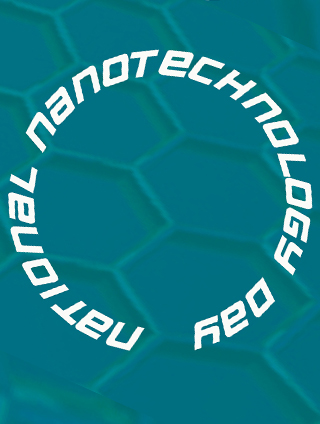
Celebrate National Nanotechnology Day with the Center for Integrated Nanotechnologies (CINT) and the Bradbury Science Museum!
Bradbury Science Museum
Los Alamos, NM
This Sunday, October 9, visit the Bradbury to find out just how long a 100-billion nanometers really is and explore
the Nano Scavenger Hunt to learn fun facts about nanotechnology and the incredible real world applications for research happening at CINT. Complete the 100-billion nanometer course or the scavenger hunt and see
the museum guides for coolprizes!
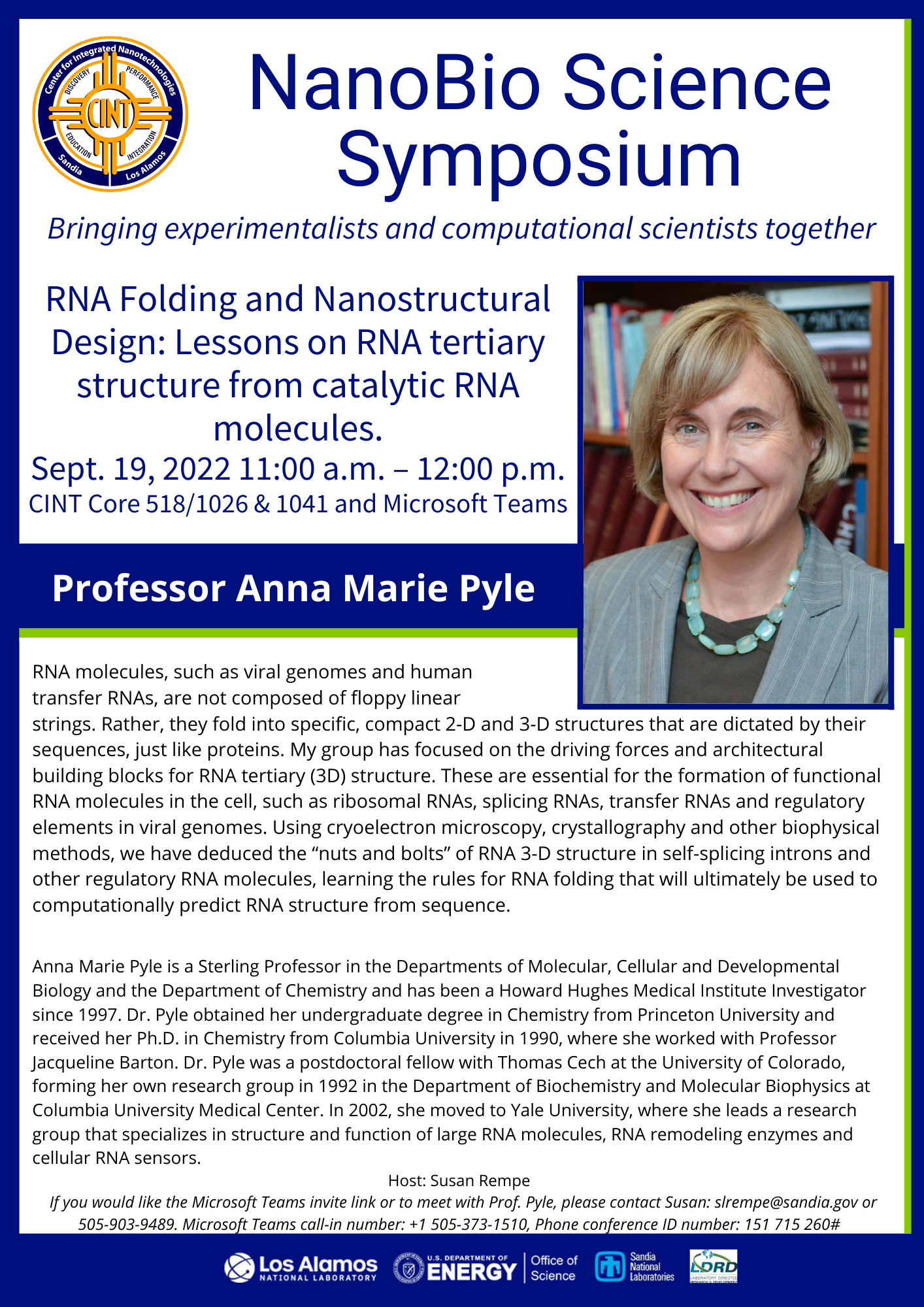
Bringing experimentalists and computaional scientists together
Center for Integrated Nanotechologies, Sandia National Laboratories
Albuquerque, NM
CINT Core Rooms 518/1026 & 1041
Virtual: Microsoft Teams
Call in number: +1 505-373-1510
Meeting ID number: 151 715 260#
Join Professor Anna Marie Pyle for her talk — RNA Folding and Nanostructural Design:
Lessons on RNA Tertiary Structure from Catalytic RNA Molecules
Abstract: RNA molecules, such as viral genomes and human transfer RNAs, are not composed of floppy linear strings. Rather, they fold into specific, compact 2-D and 3-D structures that are dictated by their sequences, just like proteins. My group has focused on the driving forces and architectural building blocks for RNA tertiary (3D) structure. These are essential for the formation of functional RNA molecules in the cell, such as ribosomal RNAs, splicing RNAs, transfer RNAs and regulatory elements in viral genomes. Using cryoelectron microscopy, crystallography and other biophysical methods, we have deduced the “nuts and bolts” of RNA 3-D structure in self-splicing introns and other regulatory RNA molecules, learning the rules for RNA folding that will ultimately be used to computationally predict RNA structure from sequence.
Host: Susan Rempe — If you would like to meet with Prof. Pyle, please contact Susan at slrempe@sandia.gov or 505-903-9489.
Registration for this event is now closed. Please join us next year for the 2023 ICE Workshop.
Center for Integrated Nanotechnologies Core Facility, Albuquerque, NM
Explore the increasing role of cryogenic electron microscopy (cryo-EM) techniques in materials science, and demonstrate innovative workflows to scientists, postdocs, and students.
The ‘ICE Workshop for Advanced Materials’ is an in-person science and training workshop combining invited lectures on current advancements and applications of cryogenic electron microscopy for materials sciences with lab demonstrations of current state-of-art cryogenic microscopy techniques.
This workshop covers each critical step of a successful cryogenic microscopy study, including specimen preparation, specimen transfer, cryogenic SEM/FIB, new cryo-EM stages, imaging, and spectroscopy at low temperatures. Vendor talks will provide information on the current state-of-the-art tools and workflows for Cryo-EM experiments. In-person lab demonstrations will be performed at CINTs Core Facility at SNL, allowing participants to have live interactions with the instructors and hands-on experience. We invite participants to bring a (3’ x 4’) poster of their work to share during the workshop. Additional pre-recorded lab demonstrations will be provided by experts from various institutions.
Organizing Committee:
John Watt, Los Alamos National Laboratory (LANL), watt@lanl.gov
Katie Jungjohann, National Renewable Energy Laboratory (NREL), katherine.jungjohann@nrel.gov
Miaofang Chi, Oak Ridge National Laboratory (ORNL), chim@ornl.gov
Minghao Zhang, University of California, San Diego, miz016@eng.ucsd.edu